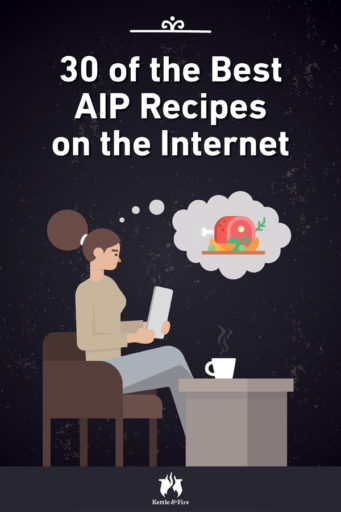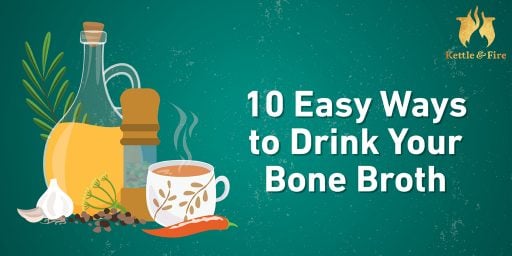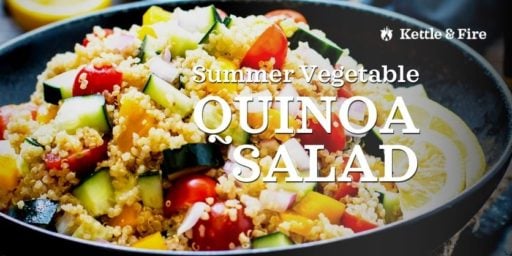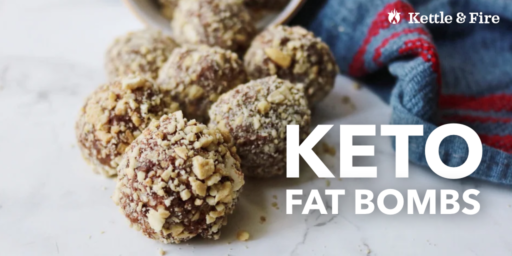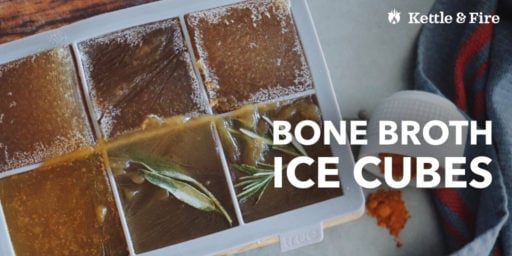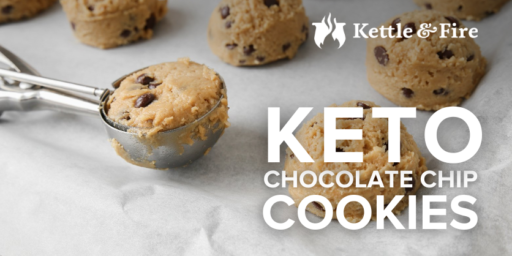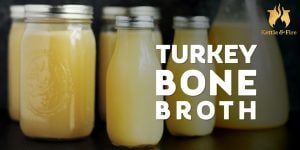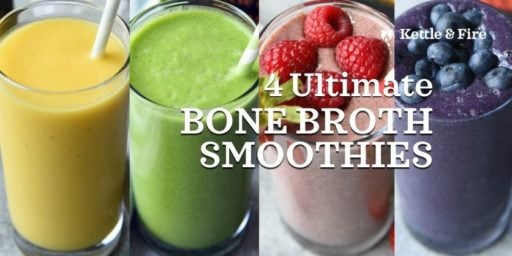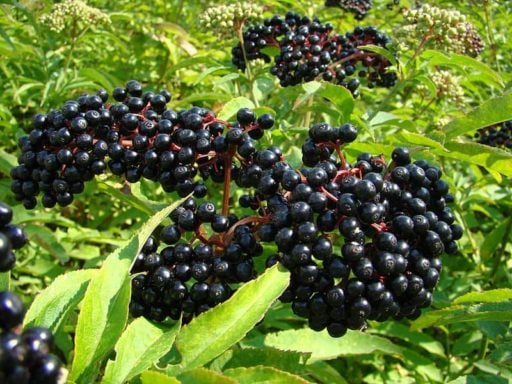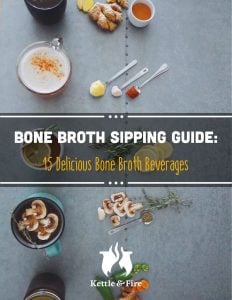30 of the Best AIP Recipes on the Internet + PDF
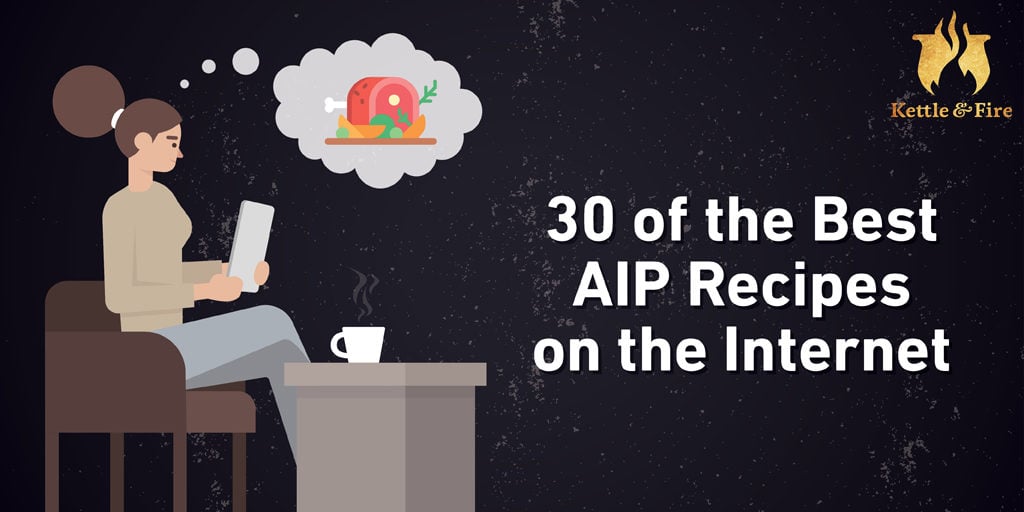
If you’ve been diagnosed with an autoimmune disease, you might have come across the autoimmune protocol diet (AIP) in researching holistic solutions. As your doctor may have already explained, autoimmune diseases are not curable. But they can sometimes be managed with proper lifestyle adjustments and supervised supplementation or medication from a licensed practitioner.
Two significant lifestyle changes you can make to get you on the path to feeling your best are mitigating stress – both physical and emotional – and developing a supportive way of eating.
The AIP diet is one way to start your journey. Intended as a temporary elimination diet, AIP is a stricter version of the paleo diet, a gluten-free, grain-free diet that also excludes legumes, most dairy, and processed sugars and oils. In addition to these restrictions, the AIP diet targets foods that trigger inflammation, exacerbating autoimmune symptoms.
The aim of an AIP lifestyle is to heal the gut by replacing pro-inflammatory foods with nutrient-containing ones, including bone broth, fermented foods and beverages, most vegetables, and some meats.
We’ve gathered a list of easy AIP recipes, plus a downloadable PDF, to help get you started in the first phase of your journey.
What Is Autoimmunity?
Autoimmunity is a malfunction in which an overactive immune system attacks healthy cells in the body. In a well-functioning individual, only pathogenic invaders (such as viruses or harmful bacteria) should trigger an attack – a healthy immune response that keeps us from getting sick. With autoimmune disease, healthy human cells are attacked, wreaking havoc on various systems of your body, and eventually causing real health problems.
As you might guess, autoimmune diseases are dangerous, often painful conditions that require a complex treatment plan in order for the patient to live a pain-free, normal life. Although medical scientists haven’t yet pinpointed every mechanism that leads to each specific autoimmune disease, at the root of these conditions is chronic inflammation in the gut.
When the gut lining is not sealed, contents that should remain inside the intestines are able to leak out into the body, setting off an inflammatory cascade that can trigger an overactive immune response. Preventing and addressing this inflammation through a gut-healing dietary protocol is one of many steps in any attempt to promote autoimmune wellness.
What Can I Eat On an Autoimmune Protocol?
The overarching goal of the AIP diet is to heal your body with gut-nourishing, nutrient-dense foods designed to quell inflammation. This includes whole fruits and vegetables (limiting fruit to two pieces per day, if fruit is tolerated at all), pastured or grass-fed meats, wild caught fish, and unprocessed sources of fat, such as avocados, coconut oil, cultured ghee, olive oil, and lard.
By default, this diet eliminates just about all processed foods, which typically contain seed and vegetable oils, processed sugars and flours, and preservatives. The limitations beyond this are a bit less obvious.
Foods to Avoid
Here are food to steer clear of in the elimination phase (1, 2, 3, 4):
- Vegetables in the nightshade family (tomatoes, potatoes, eggplant, paprika, mustard seeds, and all peppers, including dried spices like cayenne or chili powder)
- Vegetable oils (allowed: olive oil, lard, palm oil, and coconut oil)
- Dairy products (allowed: cultured ghee)
- Eggs
- All forms of sugar and alternative sweeteners (maximum 1 teaspoon of honey or maple syrup allowed per day, no other added sugar allowed)
- All processed foods (including alcohol)
- Nuts, seeds, and cooking oils made from nuts and seeds
- Beans and legumes (including coffee and soy, but not including green beans or sugar snap peas)
- Grains (including corn)
- Dried fruits
- Chocolate
- Culinary herbs and spices made from seeds (mustard, cumin, coriander, fennel, cardamom, fenugreek, caraway, nutmeg, dill seed)
- Gums (guar gum, Tara gum, Gellan gum, Gum Arabic)
- Tapioca (Start out avoiding this one, as it’s considered a “cross-reactor” with gluten. You might be able to reintroduce it after a few weeks without a problem.)
Foods to Enjoy
The following foods can be eaten on the AIP diet (3, 4, 5, 6):
- All vegetables except nightshades
- Fruit (up to 2 pieces per day)
- Pastured or grass-fed meat and poultry
- Wild-caught seafood
- Fats: olive oil, coconut oil, avocados, lard, bacon fat, cultured ghee
- Bone broth
- Coconut products: coconut oil, coconut cream, coconut butter (manna), coconut aminos, shredded coconut, coconut flour, and 100% pure coconut milk (no additives like guar gum or carrageenan; avoid cans with BPA lining)
- Not allowed: coconut sugar and nectar
- Fermented foods (coconut yogurt, kombucha, non-dairy kefir, kimchi, raw sauerkraut, fermented vegetables)
- Non-seed herbal tea
- Green tea, black tea, and white tea
- Vinegar: apple cider, coconut, red wine, balsamic (no added sugar)
- Honey and maple syrup (maximum 1 teaspoon per day)
- Herbs: all fresh, non-seed herbs
- Grass-fed gelatin and arrowroot starch
After Elimination
Once you’ve been on the AIP for a period of time (usually six to eight weeks), you’ll begin to strategically reintroduce foods from the disallowed list. This will help you discover which foods negatively impact your condition, and which foods can safely return to your diet.
We recommend keeping a food journal for this phase so that you can track your foods and your symptoms as you add them back, one at a time. It might feel overwhelming at first with all of these restrictions, but you can do it.
Autoimmune Paleo Recipes
Finding recipes that fit into the AIP lifestyle can feel challenging, especially when breakfast foods like eggs, dairy products, and grains are eliminated.
In addition to a goal of promoting nourishment and healing, you might also have a goal of keeping things simple and easy as you make these lifestyle and diet adjustments. We’ve chosen recipes that can last for multiple meals to reduce your time in the kitchen.
These meals will be heavy on the vegetables, grass-fed meats, and coconut products (like many paleo recipes you might have already tried), but absent of the foods that are triggering to those with imbalanced immune responses.
AIP Breakfast Recipes:
- AIP Baked Carrot Banana Bread N’Oatmeal (from Autoimmune Wellness)
- AIP Pumpkin Pancakes (from Gutsy by Nature)
- AIP Breakfast Sandwich (from Comfort Bites)
- AIP Granola (from AIP Lifestyle)
- AIP Warm Porridge with Lemon and Berries (from Autoimmune Wellness)
AIP Lunch Recipes:
- Shaved Brussels Sprouts Salad (from Paleo Mom)
- AIP Ramen (from Comfort Bites)
- Strawberry Kale Salad with Baconnaise (from A Clean Plate)
- Creamy AIP Chicken Salad (from He Won’t Know it’s Paleo)
- Bacon Ranch Zucchini Noodle Pasta Salad (from Unbound Wellness)
AIP Snacks:
- Turmeric and Ginger Smoothie (from Paleo Plan)
- AIP Coconut Turmeric Snack Balls (from Healing Autoimmune)
- Paleo Cheesy Garlic Kale Chips (from Healing Autoimmune)
- Nightshade-Free Red Salsa (from He Won’t Know it’s Paleo)
- Bacon-wrapped Avocado Fries (from PaleoHacks)
AIP Main Dishes for Dinner:
- Instant Pot Chicken Soup (from What Great Grandma Ate)
- Slow-cooker Ground Beef and Pumpkin Curry (from Fed and Fulfilled)
- AIP Asian Garlic Beef Noodles (from Paleo Flourish)
- Asian-Inspired Stir Fry (from Autoimmune Wellness)
- Paleo and AIP Pot Pie (from The Curious Coconut)
AIP Side Dishes for Dinner:
- Thai Cilantro Lime Cauliflower Rice (from Healing Autoimmune)
- AIP Butternut Squash Soup (from Unbound Wellness)
- Green Salad with Italian Vinaigrette (from Paleo Mom)
- Lemon Scented Roasted Vegetables with Lemon Vinaigrette (from Autoimmune Wellness)
- Curry Sweet Potato and Fennel (from Grazed and Enthused)
AIP Dessert Recipes:
- AIP Mango Lassi (from AIP Lifestyle)
- Honey Lavender Baked Apples (from A Squirrel’s Kitchen)
- Lemon Herb Shortbreads (from Eat Heal Thrive)
- Paleo Ice Cream Truffles (from Meatified)
- AIP Apple Pie (from Autoimmune Wellness)
Your AIP Meal Plan
While the AIP diet is a good place to start, a one-size-fits-all approach isn’t always the most successful option. It’s very possible that you will need to make adjustments along the way.
Your first step should always be to find a health practitioner who’s knowledgeable about your specific set of circumstances in order to find a plan that best suits your needs. Remember, no matter where you start in your AIP lifestyle, the restrictions are meant to be temporary to allow your body to begin thriving again.
Click to download a PDF of these guidelines and recipes
Pin for later:
